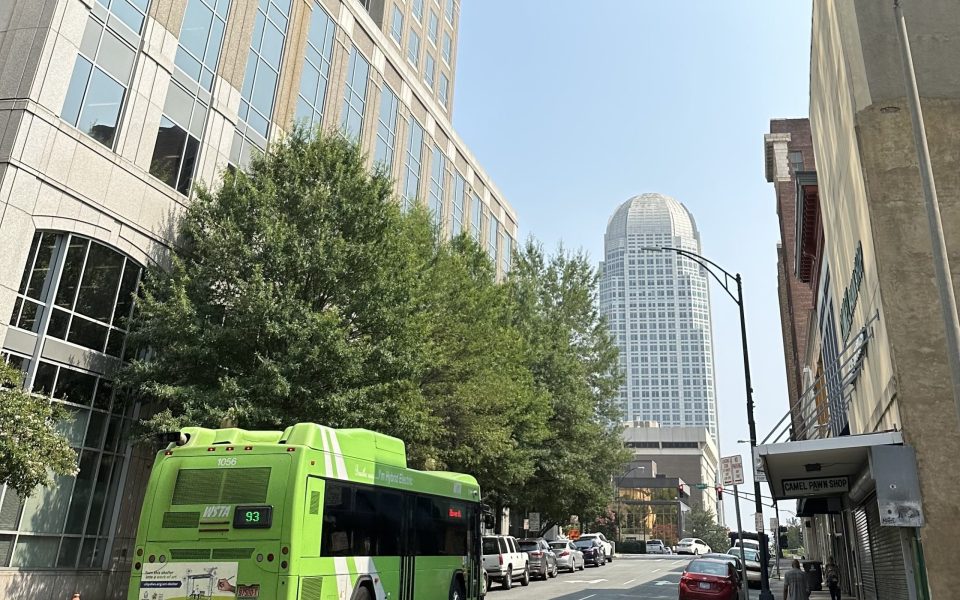Featured photo: A city bus chugs away from Clark Campbell Transportation Center along Liberty Street in downtown Winston-Salem. (Photo by Gale Melcher)
Every day, 45 bright-green Winston-Salem Transit Authority buses roll to and fro throughout the city, running along 31 fixed routes making an estimated 1,700 stops.
A 90 degree breeze swam around people waiting for their buses to arrive on a weekday afternoon at Clark Campbell Transportation Center, the city’s downtown bus hub, where dozens of rumbling buses stopped to pick up passengers before lurching on their way.
The transportation center is also a hub for bus lines such as Sunway Charters, Barons Bus and Greyhound, as well as buses with Piedmont Authority for Regional Transportation — PART — which connects riders to High Point, Greensboro, Asheboro and Chapel Hill.
One PART rider named Jonathan was hopping on the bus toward Greensboro, where he lives. Jonathan works in research in Winston-Salem, and this bus line helps him make the 30-mile commute to work since he doesn’t have a car.
While another rider named Jamar waited for a lime-green WSTA bus to pull up, he told TCB that if the city didn’t have these buses, he’d have to “walk” or “try to find a ride.”
The city is bumping up how much it spends on transit, per the recently adopted annual budget. Last year’s budget allotted more than $23.5 million to WSTA. This year, that funding has been upped to nearly $30.7 million.
The city received $6.9 million from the Federal Transit Administration this year, and the Winston-Salem Urban Area Metropolitan Planning Organization is allocating nearly $5.8 million of that to WSTA while PART will receive $723,407.
While WSTA serves as a lifeline to many city residents, it has also had its fair share of issues.
There’s been a shortage of bus drivers in recent years and ridership is half of what it was in 2019. During the 2022-23 fiscal year, more than 1.5 million people rode the bus, and by the end of this fiscal year, ridership is estimated to clock in around 1.6 million. The city also recently updated WSTA’s code of conduct and ban policy while heightening security around Clark Campbell, which is a place of refuge and resources for many homeless residents.
Jamar wishes that there was more bus service on the west side of town and further north, and doesn’t love the long wait times — most WSTA daytime routes have 1-hour frequencies whereas neighboring Greensboro’s routes run every 30 minutes. It’s important for transportation to be “available when we need it,” he said.
During May’s budget work sessions, City Councilmember Robert C. Clark complained about the addition of extra bus routes and decrease in ridership.
“Put the buses where the people are that want to ride them,” Clark said.
A massive overhaul of the city’s bus system is on its way — the city recently chose a new bus operator, RATP Dev. That decision could cost them more than $200 million over the course of seven years. With the change in transit operations, City Manager Pat Pate assured Clark that they were going to take a “significant look at our transit routes to make sure that we’re maximizing those as much as we can.”
According to a 2024 report by Forbes, around eight percent of American households do not own a car, and according to the American Public Transportation Association, 45 percent of Americans do not have any access to public transportation. According to the American Automobile Association, it costs more than $1,000 per month to own a car nowadays — not to mention what it costs to initially purchase it.
Percussionist Chi Sharpe is from Winston-Salem, but he’s “taken buses all over the world.”
While waiting for his bus to arrive, Sharpe strummed a small guitar he acquired during his time in New York City. The musician’s wrinkles deepened as he chuckled that he has “never had a car” and has always taken public transit.
Public transit can help communities become healthier — both physically and mentally. It can grant people access to healthy food, activities, employment and medical services, while reducing traffic crashes and air pollution. The social aspect of buses is also significant for riders like Sharpe. The connections spurred from conversations that take place both on and off the bus — where Sharpe said he talks to people and listens to them tell their stories — are special.
While buses have shown Sharpe new places all around the world, from Las Vegas to Germany, Canada, the Netherlands and Japan, this time he said he was “going home.”
All CityBeat reporting content is made possible by a grant from the NC Local News Lab Fund, available to republish for free by any news outlet who cares to use it. Learn More ↗
Republish this storyJoin the First Amendment Society, a membership that goes directly to funding TCB‘s newsroom.
We believe that reporting can save the world.
The TCB First Amendment Society recognizes the vital role of a free, unfettered press with a bundling of local experiences designed to build community, and unique engagements with our newsroom that will help you understand, and shape, local journalism’s critical role in uplifting the people in our cities.
All revenue goes directly into the newsroom as reporters’ salaries and freelance commissions.


My wife and I take the bus from Ardmore to downtown ALL. THE. TIME. And we get plenty of criticism for it as well from our peers. However, it is just $1, cheaper than a rideshare, it is clean and efficient and the drivers are always courteous. Plus it is a safe way to travel if one has had a drink or two too many or does not want to share the road with others who may have done the same and not been as responsible. Plus, a bus will win against most other cars. We have never had any incidents with the bus but there is the occasional passenger that makes the trip, ahem, “interesting.”
The only thing I wish the city would bring back is the real-time bus tracker but that was discontinued when the 3G network was sunset. The new app, Umo, is simply awful.
I wish more people would consider the bus system in town. It truly is a great system that can only get better.